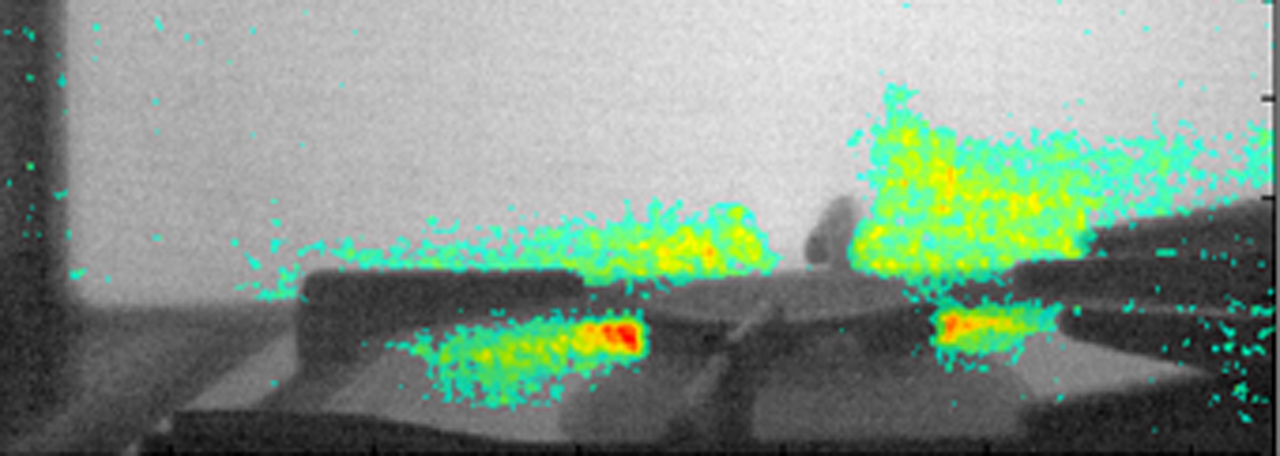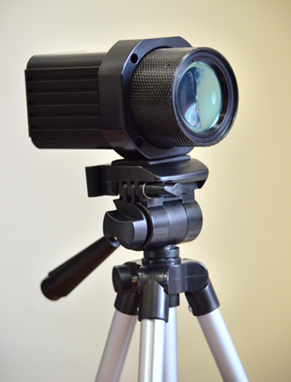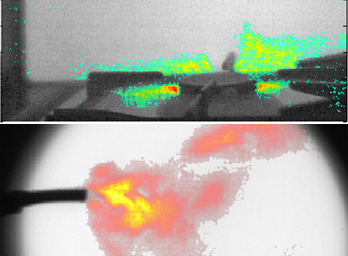Gas detection and monitoring using uncooled bolometer cameras

Introduction
Explosive and poisoned gases leakage causes the danger for people both in industry and at home. The example is the methane in coal mines. The imaging systems presenting the distribution of gas concentration from a distance is the alternative for widely-used single detector sensors. Moreover, due to the warming effect, climate changes and environment protection, there is a growing interest of using remote gas imaging systems. We do both the research and developments in this field. As the example, the high-sensitive bolometer cameras we have successfully used for detection methane, ammonia and carbon dioxide (CH4, NH3, and CO2)
- Methods
One of the research fields of Electronic Circuits and Thermography Division is modelling, design and development of thermal imaging cameras for OGI (Optical Gas Inspection). Such cameras enable stand-off gas leaks detection, what makes it a very attractive tool for many branches of industry. Thanks to the real-time operation, not only the gas leak (appearing as ‘smoke’ in the thermal image) but also its source can be identified. Optical gas imaging methods are recommended as so called Best Available Technique (BAT) for the visualisation of gas leaks. It motivated us to develop a lightweight, uncooled thermal imaging camera for the research purposes in this field.
- Results
A thermal imaging camera for OGI (Optical Gas Inspection) was designed. It is a wideband camera, what means that it operates in both MWIR and LWIR spectral ranges of infrared radiation. Thanks to being uncooled, it is much more cost effective than solutions with cooled detectors. Due to interference filters used in the optical path, it is possible to tune the sensitivity to chosen gas or gas groups only. The contrast of gas plume can be enhanced by special image processing algorithms, e.g. by overlaying colour palette into detected gas plume. For methane, the developed camera’s sensitivity is 550 ppm·m with 50 °C background.
- Conclusions
The performance of gas detection with the developed camera is a subject of research aimed at improving its capabilities for OGI purposes. The experiences in this field allow to build software tools for processing of the acquired thermal images and optimize optical path for enhance gas visibility. The ongoing research results are published in scientific papers – please refer to the Publications tab for recent achievements and current perspectives.
- Contact
- Dr. Robert Olbrycht
 , e-mail: This email address is being protected from spambots. You need JavaScript enabled to view it.
, e-mail: This email address is being protected from spambots. You need JavaScript enabled to view it.
- Dr. Marcin Kałuża
 , e-mail: This email address is being protected from spambots. You need JavaScript enabled to view it.
, e-mail: This email address is being protected from spambots. You need JavaScript enabled to view it.
- Prof. Bogusław Więcek
 , e-mail: This email address is being protected from spambots. You need JavaScript enabled to view it.
, e-mail: This email address is being protected from spambots. You need JavaScript enabled to view it.
- Dr. Robert Olbrycht
- Publication
- R. Olbrycht, M. Kałuża, Optical gas imaging with uncooled thermal imaging camera - impact of warm filters and elevated background temperature, IEEE Transactions on Industrial Electronics (Early Access), 05.12.2019, DOI: 10.1109/TIE.2019.2956412
- R. Olbrycht, M. Kaluza, W. Wittchen, M. Borecki, B. Wiecek, G. De Mey, M. Kopec, Gas identification and estimation of its concentration in a tube using thermographic camera with diffraction grating, Quantitative Infrared Thermography Journal, Vol. 15, Issue: 1, Pages: 106-120, 2018
- P. Więcek, R. Strakowski, B. Więcek, Mixed carbon dioxide and water vapour detection by using LWIR 14-16 μm high-sensitive VOx microbolometer camera – modelling and experimental results, QIRT (Quantitative InfraRed Thermography) Conference, 09.2020, Porto, Portugal



